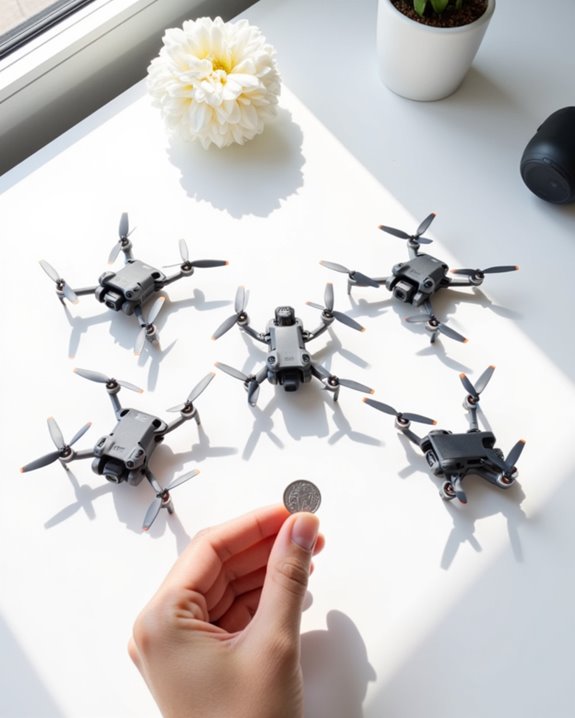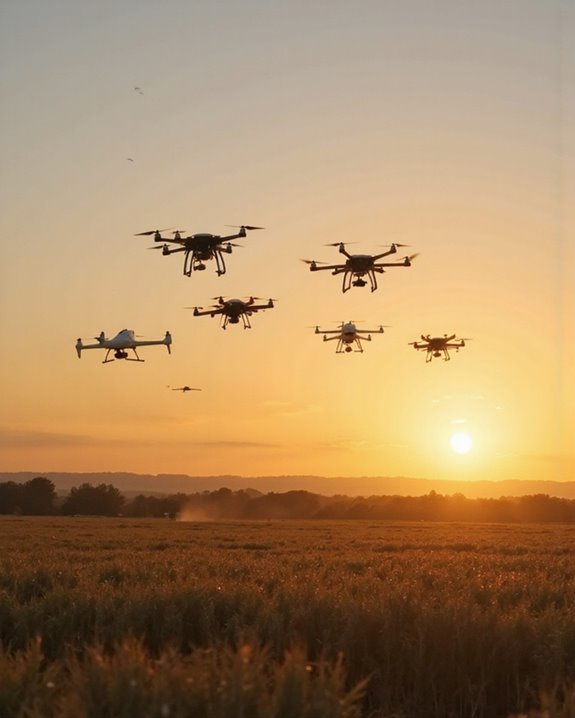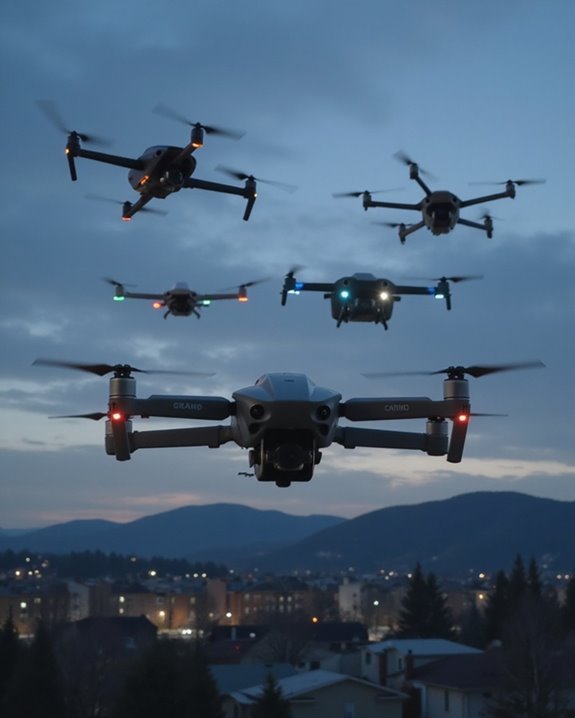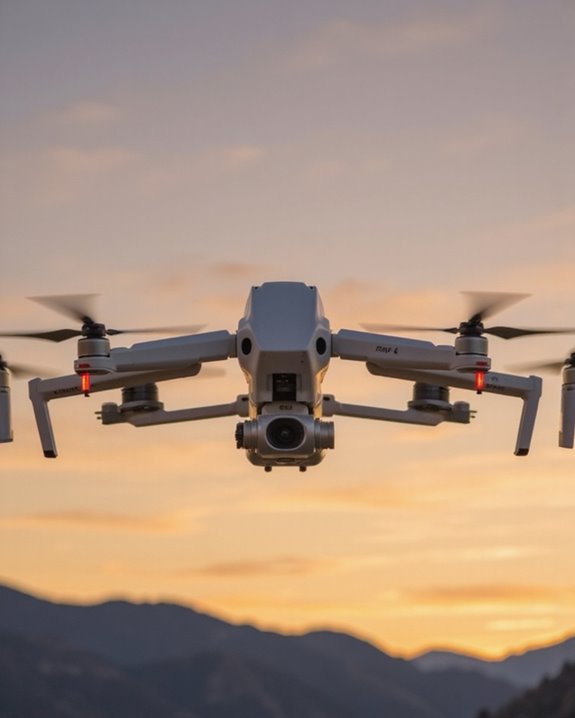You’ll love 2025’s top micro drones that deliver big performance in tiny packages! The Holy Stone HS210 offers 21 minutes of flight time with fun flips, while the HS360E captures stunning 4K footage without FAA registration at just 249g. For on-the-go adventures, the X1 Self-Flying Mini Drone includes follow-me mode at 15mph with triple-stabilized 2.7K video. These pocket-sized powerhouses prove that great things really do come in small packages!
Key Takeaways
- Holy Stone HS210 provides 21 minutes of flight time with three batteries and supports impressive aerial maneuvers like 360° flips.
- At 249g, the Holy Stone HS360E delivers 4K footage with electronic image stabilization and extensive 4-mile maximum flight range.
- The X1 Self-Flying Mini Drone captures 2.7K video with triple stabilization while weighing only 125g.
- Micro drones in 2025 offer flight times ranging from 11-21 minutes per charge, sufficient for recreational flying sessions.
- These tiny flyers feature weights between 50-250 grams, making them highly portable and exempt from FAA registration requirements.
Holy Stone Mini Drone for Kids (HS210)
- More Fun Than Others -- The drone can perform Toss to Launch, Circle Fly, 3D Flips and Auto Rotation; all kids love it! The speed can be changed to fit pilots’ flight...
- User-friendly -- The Altitude Hold function enables itself to hover at fixed height stably; under Headless Mode, directions are always relative to where pilots face;...
- 3 Batteries Extend Flight Time -- Flight time is up to 21 Minutes. Never be disappointed by a dead battery or waiting for charging! And the low battery power alarm spares...
The perfect starter drone for young aviators and beginners has arrived in the Holy Stone HS210, a palm-sized wonder that packs impressive flight capabilities into its compact 3.15-inch frame! You’ll enjoy 21 minutes of flight time with the three included rechargeable batteries, giving you plenty of practice time without constant recharging breaks.
This 50-gram lightweight flyer offers fun tricks like 360° flips, auto rotation, and circle flying that you’ll master in no time. Don’t worry about those inevitable learning crashes—the isolated propellers provide protection while you’re developing your skills. With a 160-foot range and auto-hovering capability, you’ll be zipping around confidently indoors or on calm days outside. Just keep an eye on the weather, as this little champ isn’t a fan of breezy conditions!
Best For: Children and beginners seeking an affordable, durable mini drone that’s easy to learn with multiple batteries for extended practice sessions.
Pros:
- Impressive 21-minute total flight time with three included rechargeable batteries
- Lightweight (50g) design with protected propellers makes it resilient to learning crashes
- Performs multiple fun tricks (360° flips, auto rotation, circle flying) with stable hovering capability
Cons:
- Highly susceptible to wind and even light breezes, limiting outdoor use
- Battery connectors can be difficult to remove and prone to breakage
- No on/off button and the continuous beeping in headless mode can become annoying
Holy Stone HS360E GPS Drone with 4K Camera
- Upgraded Drone for Adults: The 𝐇𝐨𝐥𝐲 𝐒𝐭𝐨𝐧𝐞 𝐇𝐒𝟑𝟔𝟎𝐄 is the 𝐞𝐧𝐡𝐚𝐧𝐜𝐞𝐝 𝐯𝐞𝐫𝐬𝐢𝐨𝐧...
- 𝟒𝐊 𝐄𝐈𝐒 𝐂𝐚𝐦𝐞𝐫𝐚 with 𝟏𝟐𝟎𝟎𝐖 𝐒𝐞𝐧𝐬𝐨𝐫: Capture professional-level videos and photos with the drone’s 4K...
- 𝟐𝟎,𝟎𝟎𝟎𝐟𝐭 𝐋𝐨𝐧𝐠-𝐑𝐚𝐧𝐠𝐞 𝐓𝐫𝐚𝐧𝐬𝐦𝐢𝐬𝐬𝐢𝐨𝐧: Enjoy long-distance control and real-time video with...
Weighing in at just 249g, this ultra-lightweight drone is a photographer’s dream come true! You’ll capture stunning 4K footage with electronic image stabilization that keeps your shots crystal-clear, even during those exciting aerial maneuvers. The HS360E doesn’t just look good on paper—it delivers impressive real-world performance with its 20,000ft transmission range and intelligent flight modes.
You’ll love the convenience of GPS auto-return and follow-me functions, perfect for when you’re focusing on adventure rather than drone control. Its brushless motors guarantee stable flight while the impressive 4-mile range lets you explore far beyond normal limitations. The best part? At under 250g, you won’t need FAA registration to start flying this compact wonder!
Best For: Photography enthusiasts and travel-loving beginners seeking a lightweight, registration-free drone with impressive 4K camera capabilities and intelligent flight features.
Pros:
- Ultralight 249g design eliminates FAA registration requirements while maintaining professional 4K camera quality with electronic image stabilization
- Impressive 20,000ft transmission range and 4-mile maximum flight distance allow for extensive exploration capabilities
- Multiple intelligent flight modes including GPS auto-return, follow me, and waypoint flight make it user-friendly for all skill levels
Cons:
- 2100mAh battery capacity may limit extended flight sessions compared to larger drones
- While the camera offers 4K resolution, professional videographers might find the CMOS sensor limiting in low-light conditions
- Though lightweight design enhances portability, it may make the drone more susceptible to wind interference during flight
X1 Self-Flying Foldable Mini Drone with Camera and Follow Me Mode
- Intelligent Follow-Me Camera: Harnessing advanced tracking algorithms and a following speed of up to 15 mph, the HOVERAir follow-me self-flying drone becomes your...
- Portability and Simplicity Redefined: Weighing a mere 125g (4.41oz), lighter than an iPhone and exempt from the hassle of FAA registration. The foldable design makes...
- Automatic and Intelligent Flight Paths: Experience hands-free flying with the pre-programmed flight paths, including Hover, Follow, Zoom Out, Orbit, Bird’s Eye, Manual...
Adventure seekers and on-the-go content creators will fall in love with the X1 Self-Flying Foldable Mini Drone, which delivers professional-quality footage without the professional-level learning curve!
You’ll enjoy 2.7K video with triple stabilization while the drone tracks you at speeds up to 15 mph. Choose from five pre-programmed paths or create your own from 20 intelligent flight options! At just 125g, you won’t need FAA registration, and its foldable design fits perfectly in your pocket.
The 32GB internal storage keeps your videos secure, while the app lets you preview, download, and share directly to Instagram. With 11 minutes of battery life per flight, you’ll capture all your adventures—no pilot’s license required!
Best For: Adventure enthusiasts, social media content creators, and sports participants who want professional-quality aerial footage without needing technical drone piloting skills.
Pros:
- Lightweight (125g) and foldable design makes it extremely portable and exempt from FAA registration requirements
- Impressive tracking capabilities with 15 mph follow speed and multiple pre-programmed intelligent flight paths
- High-quality 2.7K video with triple stabilization system creates smooth, professional-looking footage
Cons:
- Limited 11-minute battery life per charge restricts extended filming sessions
- 32GB internal storage cannot be expanded, potentially filling up during longer adventures
- Requires smartphone with compatible app for full functionality and content management
Factors to Consider When Choosing a Micro Drone

Choosing the right micro drone in 2025 isn’t just about finding the cutest flying gadget—it’s about matching features to your specific needs! You’ll want to weigh essential factors like flight time and camera resolution against practical considerations such as battery performance and how easily it fits in your pocket or backpack. Before clicking “buy now,” take time to assess each model’s safety features, including obstacle avoidance and return-to-home capabilities, which could mean the difference between enjoying your drone for years or watching it disappear into the neighbor’s tree on day one.
Flight Time and Range
The flight time and range of a micro drone can make or break your aerial adventures! Today’s top models offer impressive performance, with flight times ranging from 11 to 21 minutes per charge. You’ll find this duration directly tied to battery capacity—models sporting 2100 mAh batteries will keep you airborne much longer than those with 250 mAh power sources.
Range capabilities vary dramatically across the micro drone spectrum. Some models can soar up to an impressive 4 miles away, while others max out at just 160 feet, perfect for indoor flying or backyard exploration. Remember, these specs aren’t guaranteed! Wind conditions, flight patterns, and even how aggressively you maneuver will impact your real-world performance. For the best experience, look for drones with optimized power management—your future self will thank you when you’re capturing that extra minute of spectacular footage!
Camera Quality Considerations
While micro drones might be tiny in stature, their camera capabilities can deliver gigantic results when you choose wisely! Today’s top micro flyers pack impressive imaging tech into their diminutive frames.
Look for models offering 4K resolution rather than settling for 1080P—you’ll appreciate those extra pixels when reviewing your aerial masterpieces! Electronic image stabilization is absolutely essential, as these lightweight flyers can get bouncy in even slight breezes. For smooth footage of fast-moving subjects (like your dog zooming around the yard!), make sure your drone supports at least 30fps video capture. Consider sensors with 12MP or higher for stunningly detailed still photography, and don’t overlook HDR functionality, which will save your shots when flying between bright skies and shadowy landscapes. Your tiny drone can capture epic perspectives if you prioritize these camera features!
Size and Portability
When it comes to micro drones, size truly matters—but in this case, smaller is definitely better! Today’s top micro flyers typically weigh between 50-250 grams, making them light enough to slip into your pocket or bag without adding noticeable weight. You’ll appreciate how these tiny aircraft, often measuring just a few inches across, can fold down even smaller for travel—perfect for spontaneous flying sessions!
The 2025 models excel at combining ultra-compact designs with remarkable functionality, allowing you to carry professional-grade equipment that wouldn’t have seemed possible just a few years ago. Plus, staying under that 250-gram threshold means fewer registration headaches in most countries! Remember, the drone that gets the most airtime isn’t necessarily the most powerful—it’s the one you’ll actually carry with you everywhere!
Battery Life Factors
Beyond mere portability, your micro drone’s endurance in the air represents a make-or-break factor for capturing those perfect aerial moments! Today’s top models boast impressive battery capacities between 450-700mAh, translating to flight times of 10-30 minutes per charge. You’ll want to pay close attention to this spec when comparing options.
Safety Features Assessment
The safety features of your micro drone shouldn’t be an afterthought, but rather a top priority when making your selection! Look for models with automatic hovering capabilities, which keep your tiny flyer steady even when your piloting skills aren’t quite ready for the big leagues.
Propeller guards are absolutely essential, especially if you’ll be flying indoors or around curious pets and children. You’ll also want to prioritize drones with auto-return functionality—trust me, nothing ruins a flying session faster than watching your mini aircraft disappear over the neighbor’s fence! Emergency stop buttons can be real lifesavers when your drone decides to make an unexpected beeline for your houseplants. And don’t overlook stabilization technologies, which make flying easier and dramatically reduce those embarrassing crash landings that we’ve all experienced!
Control Mechanisms Complexity
How easily can you master your micro drone’s controls? Today’s tiny flyers offer a spectrum of complexity tailored to your skill level. Beginners can rejoice in one-button simplicity that gets you flying within minutes, while seasoned pilots might prefer the precision of advanced manual controls.
Features like auto-hovering and headless mode are game-changers for novices, taking the stress out of maintaining stability! App-based systems strike a balance, offering intuitive interfaces with real-time feedback despite requiring smartphone connectivity. For the adventurous, waypoint programming and gesture controls enable creative possibilities, though you’ll need to invest a few hours mastering these features.
Don’t worry if you’re intimidated by complex controls—intelligent flight modes can automate sophisticated maneuvers while you focus on basic inputs. You’ll be capturing dramatic swooping shots before you know it!
Indoor Vs Outdoor Usage
Deciding whether you’re an indoor flyer or outdoor adventurer fundamentally shapes which micro drone belongs in your collection! For indoor missions, look for ultra-lightweight models under 250 grams with propeller guards to protect your walls and furniture from unexpected collisions. Indoor-focused drones excel with auto-hovering features that keep them stable in still air, with flight ranges around 160 feet being perfectly adequate for home exploration.
Heading outdoors? You’ll need a drone built to battle the breeze! Outdoor micro drones require enhanced wind resistance, longer battery life (up to 21 minutes is ideal), and GPS auto-return functionality for those “where did it go?” moments. The great outdoors demands more from your tiny flyer, but the freedom of open-air flight is worth investing in those extra features. Your flying environment makes all the difference!
Frequently Asked Questions
How Long Do Micro Drone Batteries Typically Last?
You’ll be shocked at how quickly these tiny flying wonders can drain their power! Micro drone batteries typically last between 5-15 minutes of flight time. Most budget models hover around the 7-minute mark, while premium options might stretch to 15 minutes with careful flying. Your battery life depends on factors like wind conditions, flying style, and camera usage. The good news? Many micro drones come with extra batteries or quick-charging capabilities, letting you swap and get back in the air fast!
Can Micro Drones Fly Safely Indoors?
Yes, micro drones are perfect for indoor flight! You’ll find they’re specifically designed with protective propeller guards to prevent damage to your walls, furniture, and curious pets. Most models feature altitude hold functions that make maneuvering tight spaces remarkably easy, even for beginners. Just be mindful of airflow from fans or AC units, which can affect their stability. For best results, start in a larger room like your living room before attempting hallway acrobatics. They’re surprisingly forgiving little flyers!
What Are the Legal Restrictions for Flying Micro Drones?
The legal maze for micro drones might make your head spin! You’ll need to follow FAA regulations even for these tiny flyers. Don’t panic though – micro drones under 250g have fewer restrictions, but you still can’t fly near airports, over people, or beyond your line of sight. Some cities have their own rules too, so check local ordinances before takeoff. Remember, even though they’re small, you’re still responsible for flying them safely!
How Durable Are Micro Drones Against Crashes?
Micro drones are surprisingly resilient! Most models feature protective propeller guards and flexible frames that absorb impact energy, making them bounce rather than break when they hit obstacles. You’ll find entry-level drones like the HoverMini can withstand dozens of wall bumps, while premium options such as the NanoPro X incorporate advanced carbon fiber components that survive dramatic crashes. That said, water landings are still the arch-nemesis of most tiny flyers, so keep your adventures away from pools and puddles!
What Is the Average Range of a Micro Drone’s Controller?
You’ll typically find micro drone controllers with a range of 30-100 meters, though this varies greatly by model and price point. Higher-end micro drones like the DJI Mini SE push that boundary to an impressive 400 meters! Environmental factors like obstacles, interference, and weather conditions can dramatically affect your actual range experience. For indoor flyers, 30 meters is usually plenty, but if you’re taking your tiny drone to open spaces, you’ll want to check those specs carefully before purchase!








